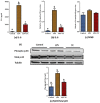Tart Cherry Reduces Inflammation in Adipose Tissue of Zucker Fatty Rats and Cultured 3T3-L1 Adipocytes
- PMID: 30366378
- PMCID: PMC6266132
- DOI: 10.3390/nu10111576
Tart Cherry Reduces Inflammation in Adipose Tissue of Zucker Fatty Rats and Cultured 3T3-L1 Adipocytes
Abstract
Obesity increases adipose tissue inflammation and secretion of pro-inflammatory adipokines, which have systemic effects on the organism's health status. Our objective was to dissect mechanisms of anti-inflammatory effects of tart cherry (TC) in adipose tissue of Zucker fatty rats, and cultured 3T3-L1 adipocytes. Rats were fed either a control diet, or 4% TC powder diets for eight weeks. Body and epididymal fat pad weights were not significantly different between control and TC groups. However, rats fed the TC diet had significantly reduced adipose tissue inflammation (p < 0.05), as determined by reduced mRNA levels of pro-inflammatory markers including interleukin-6 (IL-6), tumor necrosis factor alpha (TNFα), interleukin-1beta (IL-1β), monocyte chemoattractant protein 1 (MCP-1), inducible nitric oxide synthase (iNOS), and CD-11b, and increased mRNA levels of type-1 arginase (Arg-1) anti-inflammatory marker. Consistent with these in vivo results, TC significantly decreased expression of IL-6 mRNA and protein levels in lipopolysaccharide (LPS) stimulated adipocytes compared to those stimulated with LPS, but no TC. Moreover, both in vivo (rat adipose tissue) and in vitro (3T3-L1 adipocytes), phosphorylation of p65-NF-κB subunit was significantly reduced by TC. Additionally, TC decreased mRNA expression of fatty acid synthase (FASN), and increased expression of peroxisome proliferator-activated receptor alpha (PPARα), master regulator of lipid oxidation, and anti-oxidant markers nuclear factor erythroid-derived 2-related factor (NRFs) in both models. In conclusion, our findings indicate that TC downregulates inflammation in part via the nuclear factor kappa B (NF-κB) pathway in adipose tissue. Thus, TC may serve as a potential intervention to reduce obesity-associated inflammation.
Keywords: adipose tissue; inflammation; obesity; tart cherry.
Conflict of interest statement
S.J., A.M., S.S., J.H.K., K.C.-L. and N.M.-M. declare no conflict of interest. TC was a gift from the Cherry Marketing Institute to K.C.-L. and N.M.-M., A.J.S. received research funds from the Cherry Marketing Institute (CMI) for the animal study; however, CMI had no role or involvement in any part of this research.
Figures









Similar articles
-
Regular tart cherry intake alters abdominal adiposity, adipose gene transcription, and inflammation in obesity-prone rats fed a high fat diet.J Med Food. 2009 Oct;12(5):935-42. doi: 10.1089/jmf.2008.0270. J Med Food. 2009. PMID: 19857054
-
Mechanisms Mediating Anti-Inflammatory Effects of Delta-Tocotrienol and Tart Cherry Anthocyanins in 3T3-L1 Adipocytes.Nutrients. 2020 Oct 30;12(11):3356. doi: 10.3390/nu12113356. Nutrients. 2020. PMID: 33143330 Free PMC article.
-
Fish-oil-derived n-3 PUFAs reduce inflammatory and chemotactic adipokine-mediated cross-talk between co-cultured murine splenic CD8+ T cells and adipocytes.J Nutr. 2015 Apr;145(4):829-38. doi: 10.3945/jn.114.205443. Epub 2015 Feb 4. J Nutr. 2015. PMID: 25833786
-
Selective inhibition of sphingosine kinase-1 protects adipose tissue against LPS-induced inflammatory response in Zucker diabetic fatty rats.Am J Physiol Endocrinol Metab. 2014 Sep 1;307(5):E437-46. doi: 10.1152/ajpendo.00059.2014. Epub 2014 Jul 22. Am J Physiol Endocrinol Metab. 2014. PMID: 25053402
-
Activation of peroxisome proliferator-activated receptor beta/delta inhibits lipopolysaccharide-induced cytokine production in adipocytes by lowering nuclear factor-kappaB activity via extracellular signal-related kinase 1/2.Diabetes. 2008 Aug;57(8):2149-57. doi: 10.2337/db08-0176. Epub 2008 Apr 28. Diabetes. 2008. PMID: 18443198 Free PMC article.
Cited by
-
Effects of Tart Cherry Powder on Serum Uric Acid in Hyperuricemia Rat Model.Evid Based Complement Alternat Med. 2020 Jul 22;2020:1454305. doi: 10.1155/2020/1454305. eCollection 2020. Evid Based Complement Alternat Med. 2020. PMID: 32774405 Free PMC article.
-
Adipose tissue inflammation linked to obesity: A review of current understanding, therapies and relevance of phyto-therapeutics.Heliyon. 2023 Dec 2;10(1):e23114. doi: 10.1016/j.heliyon.2023.e23114. eCollection 2024 Jan 15. Heliyon. 2023. PMID: 38163110 Free PMC article. Review.
-
Tart Cherry Juice and Seeds Affect Pro-Inflammatory Markers in Visceral Adipose Tissue of High-Fat Diet Obese Rats.Molecules. 2021 Mar 5;26(5):1403. doi: 10.3390/molecules26051403. Molecules. 2021. PMID: 33807712 Free PMC article.
-
Mechanisms Mediating Tart Cherry and Fish Oil Metabolic Effects in Diet-Induced (C57BL/6J) and Genetically (TALYHO/Jng) Obese Mice.Nutrients. 2024 Dec 1;16(23):4179. doi: 10.3390/nu16234179. Nutrients. 2024. PMID: 39683572 Free PMC article.
-
Tart Cherry Increases Lifespan in Caenorhabditis elegans by Altering Metabolic Signaling Pathways.Nutrients. 2020 May 20;12(5):1482. doi: 10.3390/nu12051482. Nutrients. 2020. PMID: 32443669 Free PMC article.
References
-
- Word Health Organization Obesity and Overweight. [(accessed on 8 August 2018)]; Available online: http://www.who.int/mediacentre/factsheets/fs311/en/
MeSH terms
Grants and funding
LinkOut - more resources
Full Text Sources
Other Literature Sources
Research Materials
Miscellaneous

